Visually, the Hyundai IONIQ 5 makes quite an impression – almost unthinkable for a Korean car just a few years ago. But underneath the eye-catching Pixel design, the electric CUV comes across as somewhat boring, and we don’t just mean the colour. In our test, the heir to the original IONIQ proved to be a real everyday car. But don’t just take our word for it – read on to find out more.

test car price € 59,700 | Manufacturer’s website
The original IONIQ launched in Europe at the end of 2016. At the time, the car was available in all-electric, self-charging hybrid and plug-in hybrid versions, but for the first three years of production it had to make do with a small 28 kWh battery and a power output of just 88 kW (120 hp). Nevertheless, the IONIQ can rightly be considered a pioneer of electric mobility – much like the world’s best-selling electric car for many years, the Nissan Leaf. For Hyundai, the IONIQ marked the start of a new era for the company, which until then had been known as conservative and, let’s face it, boring. Although the first IONIQ was still restrained in its design, Hyundai had already fully embraced the unique features and details associated with electric cars by 2016.

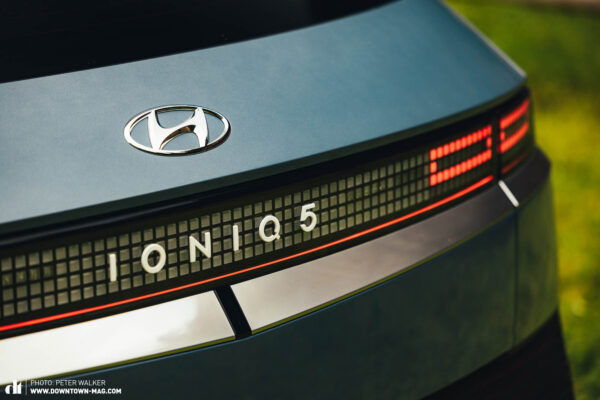
However, the current IONIQ 5 has little in common with its predecessor, apart from electrification of course. While the first IONIQ was a conservative and understated car whose design was primarily driven by function, notably aerodynamics, the design language of the IONIQ 5 has undergone a complete transformation. In fact, this shift is now prevalent in the majority of cars produced by the Hyundai Motor Group with their two major brands, Hyundai and KIA. In recent years, the South Korean company have successfully rebranded themselves, moving away from their reputation as a cheap brand with uninspiring design and mediocre quality. They have become known for quality craftsmanship and extended warranties, while still remaining good value for money. They’re also becoming known for their bold, innovative electric car designs.
Fancy spaceship or stylish workhorse – The Hyundai IONIQ 5 in detail
Despite having been on the road since mid-2021, the IONIQ 5 is still a bold design. At first glance, the bulky front panel with its Pixel design looks a bit like a spaceship. The Pixel design language is consistent throughout the car, both inside and out, without appearing artificial or contrived. In this respect, Hyundai join the ranks of numerous electric car start-ups such as Fisker, Nio or Lucid, but with one key difference – Hyundai have over 50 years of corporate history and expertise. IONIQ represents Hyundai’s commitment to electric drive. Although the Hyundai logo still adorns the car, the South Korean manufacturer have established the IONIQ brand as so distinctive that it could potentially stand alone.


Our test car is finished in Lucid Blue, a choice that somewhat diminishes the IONIQ 5’s futuristic appeal. Rather than exuding a “lucid” aura, the paintwork comes across as lacklustre and even a little old-fashioned, a stark contrast to the innovative design of the Robodog (it’s worth noting that robot manufacturer Boston Dynamics is also part of the Hyundai group). It is also the cheapest colour option, with all of the other colours subject to a surcharge of between € 330 and € 990. In terms of equipment, we chose the “practical” model, which includes a substantial 77.4 kWh battery, 168 kW (229 hp) of power and rear-wheel drive. Inside, it has TECHNIQ features and a seat package with practical amenities such as Matrix LED lighting, heated front and rear seats, ventilated front seats and a heatable steering wheel. Below this range is the DYNAMIQ line and the base model, priced at € 43,900. The entry-level version of the IONIQ 5, however, is equipped with a smaller 58 kWh battery.
Hyundai’s approach of not forcing customers into rigid packages is highly commendable. They allow additional extras within each trim level and these extras are not dependent on each other. For example, the larger battery always costs an extra € 4,000 and the four-wheel drive an extra € 8,000. This means that the larger battery and four-wheel drive are also available on the base model. Such flexibility is a rarity in today’s car industry. In addition, the top trim level, known as UNIQ, costs € 14,000 more than the base version and offers a wealth of customisable options. This can push the price up to € 65,000, especially with the optional towbar, which can tow up to 1,600 kg, depending on the engine.
Inside and out – A closer look at the Hyundai IONIQ 5
At first glance, it is clear that Hyundai is no longer synonymous with simple and cheap, but with design and quality. The panel gaps are consistent, and the rims give a sporty impression. Another good solution is the “fuel filler flap”, which doubles as a small rain cover for the charging plug and can be opened with the key. Speaking of keys: Keyless Go, or Smart Key as Hyundai calls it, is also included. Inside, the materials used are high quality, at least where visible. In-keeping with the price range, however, there is a noticeable quality equator at waist level. The IONIQ 5 has a lot of hard plastic below the belt, but it would be asking a lot to expect more at this price bracket.
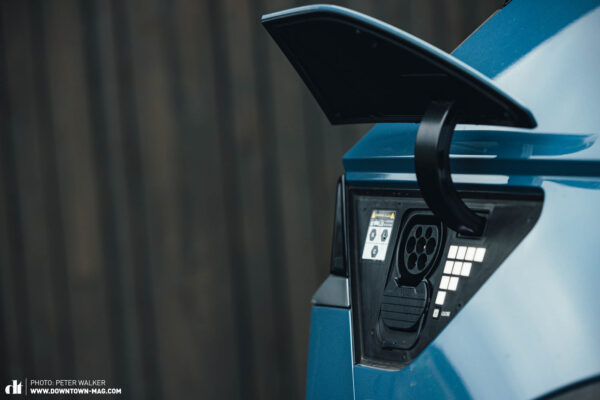
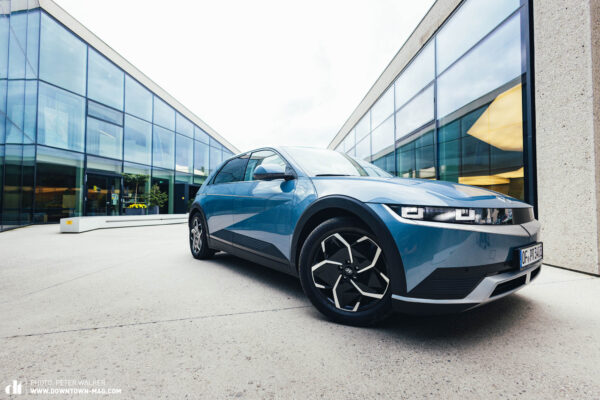
The first thing that catches your eye as you get into the car is the centre console, which offers so much storage space that you could almost call it a “third boot”. Hyundai are also breaking new ground with the glove compartment, which in the IONIQ 5 is designed as a drawer instead of a flap. This makes it easier to find things, assuming your passenger’s knees allow you to open it at all. The large, two-part display is designed to help you reach your destination – and it works perfectly. However, if the South Koreans had used a black bezel instead of a white one, it would have given the impression of one continuous display wall, which we would have favoured.

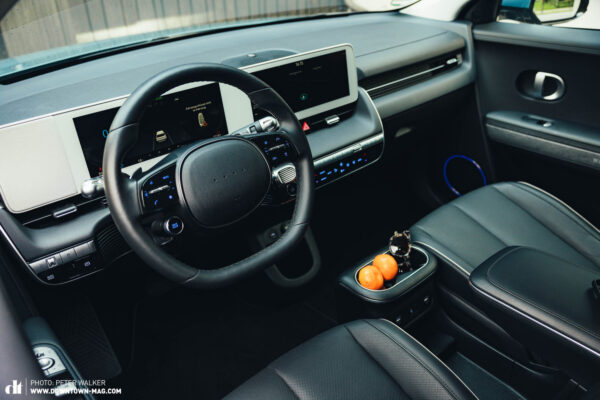
In general, the Hyundai exhibits no significant weaknesses. The seats are comfortable and suitable for people of various sizes and body types. You shouldn’t expect a sporty experience, but what you can count on is long-distance comfort. The rear seat is also comfortable, although the floor is too high – as it is in almost all electric cars – so there is little thigh support for taller passengers. At least the backrest can be reclined in three positions, but only the normal and the flatter positions are really suitable for sitting. The latter invites you to lounge comfortably, as long as a giant isn’t sitting in front of you. The upright position, on the other hand, only serves to increase the boot space a little. Unfortunately, the sloping rear window takes away valuable space. The size of the boot is fine, although it might be a bit on the small side for a family of four. Luckily, the floor of the double luggage compartment can be lowered by a further 15 cm if more space is needed. The frunk also has a good size and is sufficient for charging cables and small items. However, the placement between cables and hoses seems rather perfunctory.
The Hyundai IONIQ 5 isn’t as antagonistic as its edgy Pixel design suggests – but it’s not a car for everyone.
Hyundai IONIQ 5 assist systems – Good, with room for improvement
Two side-by-side 12.25″ displays handle all the infotainment. On the left you mainly see driver information, on the right navigation, entertainment and settings. It is also easy for the passenger to reach. Unfortunately, the palm rest is well-intentioned rather than well-made – it is simply placed too low for anyone other than Mr. Tickle. A head-up display is reserved for the UNIQ line. If you are unhappy with the existing infotainment or want to use additional features, Apple CarPlay and Android Auto are also available. But beware: during our test, the charging cradle turned out to be a disguised Faraday cage, swallowing up almost every mobile phone and GPS signal. As in almost all modern cars, your fingers will find a mixture of physical buttons and touchscreen controls, but especially for the climate control we would have liked to see real buttons. On the other hand, less would have been more with the multifunction steering wheel, which is already overloaded with buttons and switches, including an additional gear selector. The paddles behind the wheel can be used to adjust the regenerative braking from “against the wall” to sailing. True one-pedal driving to a complete halt is also possible. The driving mode is selected using a button on the steering wheel. However, nothing changes apart from the power delivery.


The system works quickly most of the time and reacts largely without delay. However, zooming in and out of the map is a little jerky. The operation is not always the most logical either. For example, the difference between the Map and Navigation options is a little confusing, something you will probably first notice when you want to return to an active navigation screen. Tip: Don’t select the Navigation option. Four USB ports are distributed inside, all still USB-A. The sound system doesn’t really deserve the name, with particularly weak treble output. Young children – and their parents – will enjoy the quiet mode, which means no music in the rear and only a subdued sound in the front, particularly useful on long journeys or overnight trips.
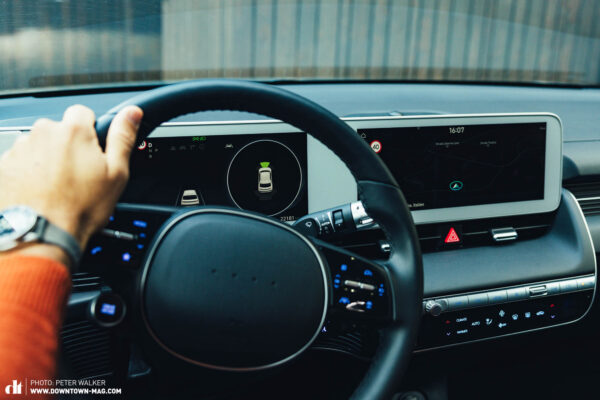

The cruise control is sensitive and adapts to traffic conditions, which is particularly useful on the motorway. On the other hand, if you drive in a more sporty manner, the cruise control adjusts accordingly. Sometimes, however, it simply switches off without warning. There is also room for improvement in the sign recognition system. Here, the IONIQ 5 likes to detect signposts on slip roads or in adjacent lanes – and brakes accordingly when the cruise control is linked to the sign recognition. The Lane Keep Assist only works as expected on motorways, and only when lane markings are clearly visible. However, sometimes the car steers too gently and gets so close to the line that the Lane Assist starts beeping – a little alarming when the car is supposed to have this all under control. Roadworks make you feel even more insecure. You really cannot call it an autopilot here. At least the Hyundai IONIQ 5 manages regenerative braking autonomously when using cruise control, and adapts well to the driving situation. The recognition of other road users also works very well, they are displayed as blocks on the dashboard.
Hyundai IONIQ 5 – Range, charging and consumption
Hyundai state a range of 507 km for the 77.4 kWh version with rear-wheel drive. From our extensive test rides with mixed driving patterns, it is clear that this can only be achieved with an extremely restrained driving style. But with our overall average of 17.4 kWh, we still managed a respectable range of 440 km. Thanks to the 800 Volt system, this is not such a concern anyway. After all, the IONIQ 5 is designed to charge at up to 240kW and, more importantly, maintain this high level of power for a long time. 18 minutes from 10-80% is the manufacturer’s claim – impressive. We didn’t quite reach 240 kW, charging anywhere between 150 and 220 kW. In fact, the charging power remains high for a long time, which, together with the automatic battery pre-heating, makes the IONIQ 5 a car for everyday use. The 11 kW charging capacity at AC charging stations is now standard. Unfortunately, this doesn’t apply to the heat pump, which is only fitted as standard from the DYNAMIQ package onwards, but otherwise costs a hefty € 1,200 extra.
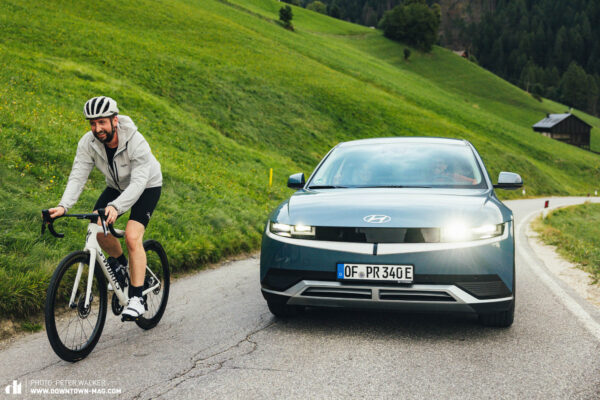

From the second most expensive TECHNIQ range upwards, a 230V socket is fitted under the rear seat, a very useful feature for working on a laptop in the back, for example. The UNIQ package also includes a 230 V adapter for the charging connection so that the power from the battery can also be used for external consumption. Unfortunately, neither of these features are available in the two lower packages.
Driving impressions of the Hyundai IONIQ 5 – From leisurely to exhilarating
Before it can start, the door has to be closed. Easy, right? Sure, but in the IONIQ 5 it doesn’t work quite the way you’re used to. Instead of a recessed handle in the door, the entire door armrest acts as a handle. But after a bit of fussing with the door, we soon got used to it. When you put the pedal to the metal, the Hyundai IONIQ 5, despite its 229 bhp, is more of a leisurely cruiser than a sprinting speedster, but that suits an everyday family car just fine. Less welcome, however, is the fact that the rear-wheel drive tends to result in a slightly lively back end. Especially on wet or slippery roads, it shimmies like a catwalk model, with the ESP only intervening at the last moment. This inconsistency makes the IONIQ 5 a bit of a lucky dip bag. On the one hand comfortable and well suited to electric beginners, on the other impetuous and tail-heavy. The powerful rear-wheel drive is complemented by a very quiet chassis with a firm set-up that hardly rolls or wobbles, even during load changes and fast cornering. This is quite a contrast from its sibling from sister brand KIA, the EV6– in spite of the identical E-GMP platform. When accelerating hard, the KIA first drops to its knees at the rear and starts to jump like a Jaguar. In the end, the Hyundai IONIQ 5 presents a somewhat ambiguous picture on the road. At first glance it appears to be a mild-mannered family car, but a closer look reveals a sporty tuning with late intervening ESP. This means that the car probably doesn’t feel safe and soft enough for everyone, but with a light touch on the accelerator anyone can control it or, conversely, indulge in some spirited driving.


A seemingly minor detail, but one that becomes apparent on closer inspection, is the lack of a rear window wiper. Hyundai seem to think that the distinctive spoiler design with small air vents is enough to keep the rear window clean. This is not the case. After a short drive in the rain, visibility through the rear window is severely impaired and when parking, the now dusty rear view camera can become quite annoying.
Who is the Hyundai IONIQ 5 for?
The Hyundai IONIQ 5 is a bit like a one-size-fits-all: It kind of fits everyone, but not really anyone. The car is undoubtedly a real all-rounder with sophisticated, well thought-out electric features. Families will appreciate the spacious interior and easy-to-use load compartments, but probably not the rear-heavy handling, which requires careful driving. On the other hand, the sporty driver will find the power delivery too moderate, and the business driver may find the car lacks that luxury-class feel. The bottom line is that the Hyundai IONIQ 5 is a real everyday car, solid and down-to-earth, with cool, spaceship styling that we’re starting to get used to.

Conclusion on the Hyundai IONIQ 5
Design, electric technology and workmanship – the Hyundai IONIQ 5 has it all and is one of the most advanced and most popular electric cars on the market today. Yet the IONIQ 5 is a car of contradictions: Too lively to be a sedate shopper, too sluggish for a sporty electric car, and there is still room for improvement in the assist systems. In the end, the result is a solid, reliable electric car with slight weaknesses.
Tops
- bold design language
- advanced electric features with fast DC charging technology
- true everyday car
- fair configuration options on the home page
Flops
- tends to oversteer early
- delayed ESP intervention
- no rear window wiper
More information via hyundai.com
Words: Patrick Gruber Photos: Peter Walker







